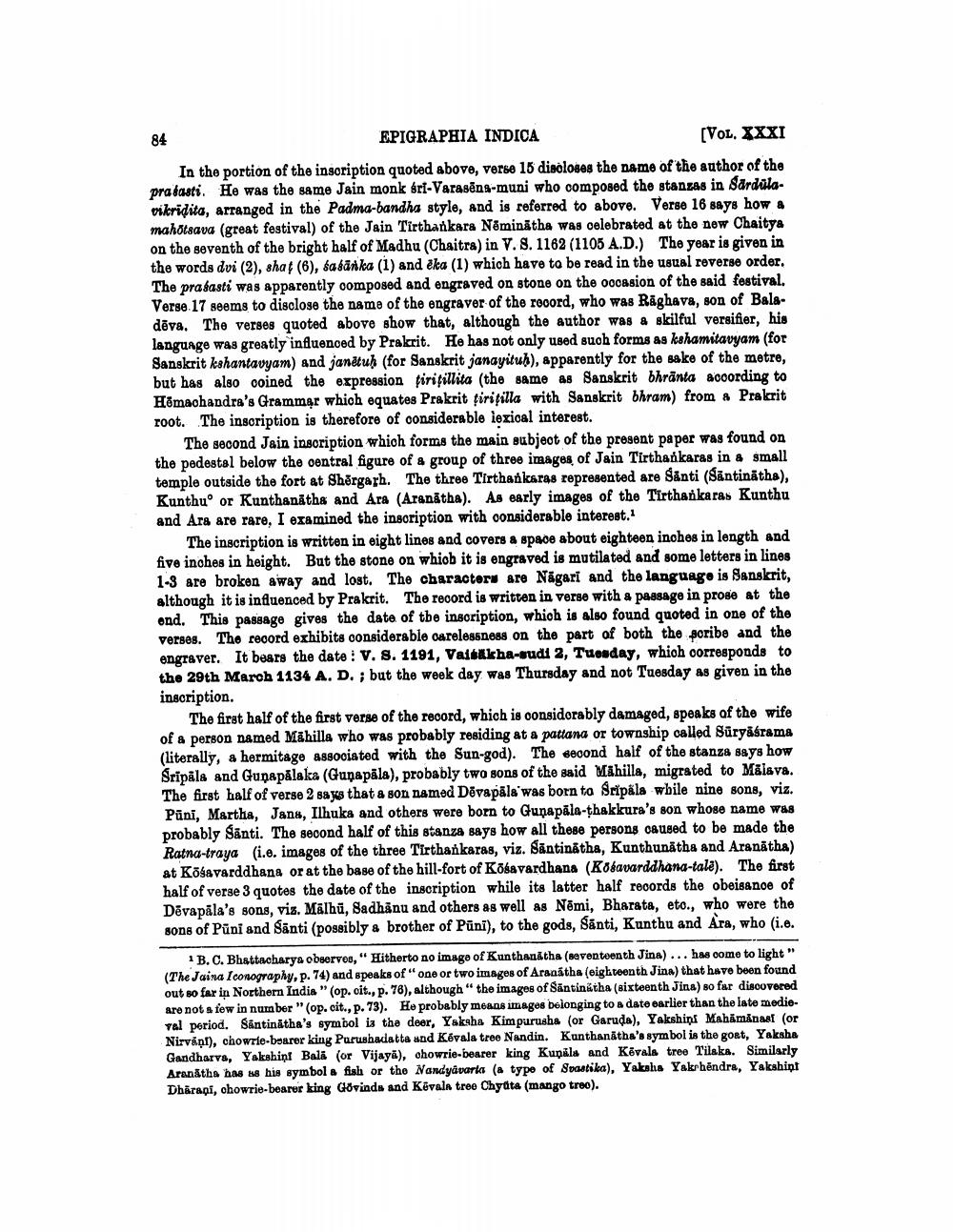________________
84
EPIGRAPHIA INDICA
[VOL. XXXI
In the portion of the inscription quoted above, verse 15 discloses the name of the author of the pralasti. He was the same Jain monk éri-Varasens-muni who composed the stanzas in Sardulavikridita, arranged in the Padma-bandha style, and is referred to above. Verse 16 says how a mahotsava (great festival) of the Jain Tirthankara Neminatha was celebrated at the new Chaitya on the seventh of the bright half of Madhu (Chaitra) in V. S. 1162 (1105 A.D.) The year is given in the words dvi (2), shat (6), sasanka (1) and ěka (1) which have to be read in the usual reverse order. The prasasti was apparently composed and engraved on stone on the occasion of the said festival. Verse 17 seems to disclose the name of the engraver of the record, who was Raghava, son of Baladeva. The verses quoted above show that, although the author was a skilful versifier, his language was greatly influenced by Prakrit. He has not only used such forms as kehamitavyam (for Sanskrit kshantavyam) and janētuḥ (for Sanskrit janayituh), apparently for the sake of the metre, but has also coined the expression firitillita (the same as Sanskrit bhränta according to Hemachandra's Grammar which equates Prakrit țiritilla with Sanskrit bhram) from a Prakrit root. The inscription is therefore of considerable lexical interest.
The second Jain inscription which forms the main subject of the present paper was found on the pedestal below the central figure of a group of three images of Jain Tirthankaras in a small temple outside the fort at Shergarh. The three Tirthankaras represented are Santi (Santinätha), Kunthu or Kunthanatha and Ara (Aranatha). As early images of the Tirthankaras Kunthu and Ara are rare, I examined the inscription with considerable interest.1
The inscription is written in eight lines and covers a space about eighteen inches in length and five inches in height. But the stone on which it is engraved is mutilated and some letters in lines 1-3 are broken away and lost. The characters are Nagari and the language is Sanskrit, although it is influenced by Prakrit. The record is written in verse with a passage in prose at the end. This passage gives the date of the inscription, which is also found quoted in one of the verses. The record exhibits considerable carelessness on the part of both the scribe and the engraver. It bears the date: V. S. 1191, Vaisakha-sudi 2, Tuesday, which corresponds to the 29th March 1134 A. D. ; but the week day was Thursday and not Tuesday as given in the inscription.
The first half of the first verse of the record, which is considerably damaged, speaks of the wife of a person named Mähilla who was probably residing at a pattana or township called Süryasrama (literally, a hermitage associated with the Sun-god). The second half of the stanza says how Sripala and Gunapalaka (Gupapala), probably two sons of the said Mähilla, migrated to Malava. The first half of verse 2 says that a son named Devapala was born to Sripala while nine sons, viz. Pūni, Martha, Jana, Ilhuka and others were born to Gunapala-thakkura's son whose name was probably Santi. The second half of this stanza says how all these persons caused to be made the Ratna-traya (i.e. images of the three Tirthankaras, viz. Santinatha, Kunthunatha and Aranatha) at Kōsavarddhana or at the base of the hill-fort of Kõsavardhana (Kosavarddhana-tale). The first half of verse 3 quotes the date of the inscription while its latter half records the obeisance of Devapala's sons, viz. Malhü, Sadhānu and others as well as Nemi, Bharata, etc., who were the sons of Puni and Santi (possibly a brother of Puni), to the gods, Santi, Kunthu and Ara, who (i.e.
1 B. C. Bhattacharya observes," Hitherto no image of Kunthanatha (seventeenth Jina)... has come to light" (The Jaina Iconography, p. 74) and speaks of " one or two images of Aranatha (eighteenth Jina) that have been found out so far in Northern India " (op. cit., p. 78), although " the images of Santinätha (sixteenth Jina) so far discovered are not a few in number "(op. cit., p. 73). He probably means images belonging to a date earlier than the late medieval period. Santinätha's symbol is the deer, Yaksha Kimpurusha (or Garuda), Yakshini Mahämänas! (or Nirvant), chowrie-bearer king Purushadatta and Kevala tree Nandin. Kunthanatha's symbol is the goat, Yaksha Gandharva, Yakshini Bala (or Vijaya), chowrie-bearer king Kupala and Kevala tree Tilaka. Similarly Aranatha has as his symbol a fish or the Nandyavaria (a type of Svastika), Yaksha Yakrhendra, Yakshipt Dharaçi, chowrie-bearer king Govinda and Kevala tree Chytta (mango tree).




